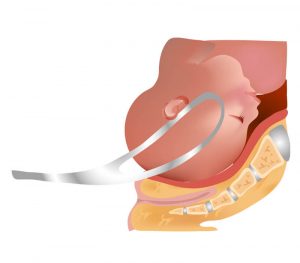Delivery with Forceps: What is it, and When is it a Good Idea?


Written and verified by the psychopedagogue Leticia María Fernández Gutiérrez
Have you heard of delivery with forceps? You’ve probably heard a lot of stories about the use of this instrument to help the baby exit the birth canal. We want to give you all the facts about how it works and when its use is recommended.
Delivery with forceps is a type of instrumental delivery that is only used in very specific situations. Forceps are a type of tong used to help the baby finish leaving the birth canal.
On one end, it has two paddles which are introduced into the vagina. They are perfectly shaped to mold themselves around the baby’s head.
Although they’ve been considered dangerous for a long time, we want you to know everything about when it’s advisable to use forceps during delivery, as well as the risks involved in their use.
When Delivery with Forceps is Recommended
Delivery is a natural process, but a complex one. Complications sometimes arise that require elements that aren’t strictly natural. This is the case for delivery with forceps.
The most frequent reasons are:
- Fetal Distress. The baby needs to exit the birth canal faster than the rhythm of delivery that is occurring, which can increase the fetus’ stress level.
- Fatigue for the mother. Labor can last many hours, and sometimes the mother can become completely exhausted, which impedes her ability to push with the required force.
- Exiting is impossible. After too many hours of labor, the baby needs some extra help to exit the birth canal.
Although you may think these reasons are common in any delivery, only in very specific cases, and while strictly monitoring your baby’s position will the medical team determine that forceps are necessary.

Extra help only applies when the baby is 2-3 centimeters from the end of the canal.
They used to believe they could use forceps to help once the baby was 10 centimeters away, but it has been shown that delivery with forceps is effective as the last assistance for the baby.
Beyond the reasons above, a series of requirements must be met:
- Uterus is fully dilated.
- Amniotic sac is broken
- The baby’s head fits
Giving birth is the only pain that is worth suffering.
Risks of Delivery with Forceps
Instrumental deliveries carry added risks beyond those of normal delivery. The medical team weighs these risks when making a decision to choose to delivery with forceps.
They only decide to use forceps when the conditions are the most favorable and the risks are minimized as much as possible.
The risks of delivery with forceps are:
- For the mother, vaginal tearing, in the perineum and the anal sphincter. This can lead to incontinence or fistulas, although normally these symptoms and ailments lessen throughout the postpartum period.
- More care for the episiotomy scar. The incision is somewhat bigger, so it needs more care.
- More blood loss during delivery. It’s still an instrument being inserted into an area that is already very sensitive and painful.
- For the baby, it may lead to contusions or bruises, which usually go away in a few days.
- In some cases, a facial nerve can be compressed, leading to minor paralysis. This normally goes away in a few days.
Skull fractures and complications that are life threatening for the mother or baby are very rare.

Interesting Facts about Forceps
There are many historical references to forceps. However, it is believed that they were first used to deliver babies in the 16th century. In fact, their use as an instrument to help during childbirth was kept secret for 100 years.
The Chamberlen family of doctors became the best obstetricians of the era thanks to their “secret:” the use of forceps. If you want to learn more about this story, visit the following link.
This text is provided for informational purposes only and does not replace consultation with a professional. If in doubt, consult your specialist.
